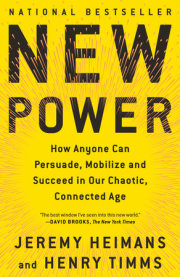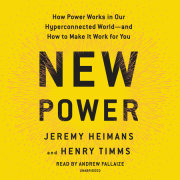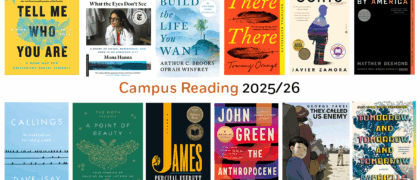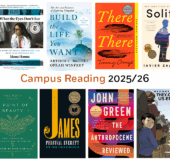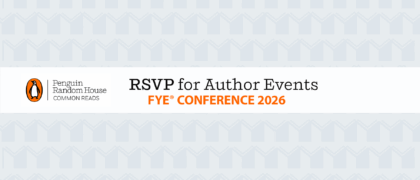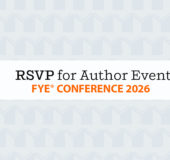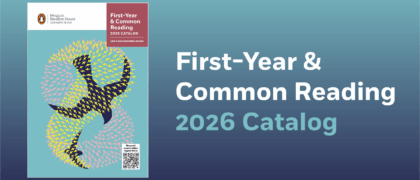1WELCOME TO THE NEW POWER WORLDPower, as philosopher Bertrand Russell puts it, is the “ability to produce intended effects.”
That ability is now in all of our hands. Today, we have thecapacity to make films, friends, or money; to spread hope orspread our ideas; to build community or build up movements; to spread misinformation or propagate violence—all on a vastly greater scale and with greater potential impact than we did even a few years ago.
Yes, this is because technology has changed. But the deeper truth is that we are changing. Our behaviors and expectations are changing. And those who have figured out how to channel all this energy and appetite are producing Russell’s “intended effects” in new and extraordinarily impactful ways.
Think of the hoodie-clad barons who sit atop online platforms a billion users strong, tweaking our daily habits, emotions, and opinions. The political neophytes who have raised passionate crowds and won stunning victories. The everyday people and organizations who are leaping ahead in this chaotic, hyperconnected world—while others fall back.
This book is about how to navigate and thrive in a world defined by the battle and balancing of two big forces. We call them old power and new power.
Old power works like a currency. It is held by few. Once gained, it is jealously guarded, and the powerful have a substantial store of it to spend. It is closed, inaccessible, and leader-driven. It downloads, and it captures.
New power operates differently, like a current. It is made by many. It is open, participatory, and peer-driven. It uploads, and it distributes. Like water or electricity, it’s most forceful when it surges. The goal with new power is not to hoard it but to channel it.
To start to see how old and new power work, here are three very different stories.
#MeToo vs. Harvey Weinstein
Award seasons after award season, movie producer Harvey Weinstein ruled over Hollywood like a god.
In fact, between 1966 and 2016, he actually tied with God for the total number of times each was thanked in acceptance speeches on Oscar night—thirty four. His films garnered over three hundred Oscar nominations. The Queen made him an honorary Commander of the British Empire.
Weinstein hoarded his power and spent it like currency to maintain his vaunted position: he could make or break a star, he had huge personal capacity to green-light a project or sink it. He shaped the fortunes of an entire industry—and in turn that industry protected him even as he carried out a decades-long spree of alleged sexual harassment and assault. He controlled the media through developing a cozy mutually beneficial relationship based on the favors and access he could grant. He even won the 2017 Los Angeles Press Club “Truth Teller” award.
He buffeted himself with an army of lawyers, relying on punishing non-disclosure agreements for those who worked with him and, when necessary, paying off accusers. He hired private security firms—staffed with former spies—to dig for information on women and journalists with allegations against him. The women he preyed upon mostly kept quiet anyway, out of the very real fear of career consequences, while the men who might have stepped up stood by and did nothing, unwilling to spend their own power on a fight.
If Harvey Weinstein, and the closed and hierarchical system that held him up, tell a familiar story about old power, then Weinstein’s fall, and especially what happened next, tells us a lot about how new power works, and why it matters.
In the days after news stories broke about Weinstein and his accusers, the actress Alyssa Milano shared the hashtag #MeToo to encourage women to tell their stories of sexual harassment and assault on Twitter. Terri Conn paid attention. In her twenties, as an emerging actress with a role on a soap opera, Conn had been approached by director James Toback to meet in Central Park to talk about a part. Once there, as she reported to CNN, he assaulted her.
She buried the memory for years. But with the attention on Harvey Weinstein, and the rise of the #MeToo movement, it resurfaced. She finally told her husband, and she started to act. She began by searching Twitter for women who had used both the #MeToo hashtag and #JamesToback. She found others whose stories were frighteningly close to hers. Together they formed a private Twitter group to support one another and find other survivors. Members of this group then took their stories to a journalist at the Los Angeles Times. Within days of an article being published, more than three hundred women came forward with stories of their own about Toback.
Conn’s campaign was one of many. Almost one million tweets used the hashtag #MeToo in forty-eight hours. In just one day, twelve million Facebook comments, posts, and reactions were logged.
The #MeToo movement surged across the world like a current, with different communities adapting it to take on their own targets. In France it became #BalanceTonPorc (Denounce Your Pig), a campaign to name and shame harassers. In Italy women recounted their stories under the banner #QuellaVoltaChe (The Time That). And it moved from industry to industry. Members of Congress revealed that they, too, had been harassed by their male peers. The UK defense minister was forced to resign. The European Parliament had its #MeToo moment. Business leaders were exposed and toppled. Rallies spilled out onto the streets in cities across the world, from Paris to Vancouver. India debated an effort to expose the predatory behavior of well-known professors. An article in
China Daily that seemed to suggest workplace harassment and assault were only Western problems was pulled after a wave of online criticism.
No one was the boss of this movement, and no one quite knew where it would go next. #MeToo had been born a decade earlier as the work of grassroots activist Tarana Burke, who encouraged women of color who had been sexually assaulted to share their experiences, peer-to-peer, with other survivors. But now the movement felt ownerless—and this was the source of its strength. Everyone from enterprising designers who created “me too” jewelry to aspiring politicians who aligned with #MeToo to seek to channel its energy.
The most striking thing about #MeToo was the sense of power it gave to its participants: many who had felt for years that they were helpless to stop longtime abusers, or had been afraid of retribution, suddenly found the courage to stand up to them. Every individual story was strengthened by the surge of the much larger current. Each individual act of bravery was, in fact, made by many.
The patient(s) vs. the doctorThe doctor looked up from his computer, stunned. “Where didyou learn that word? That’s my terminology. When did you go to medical school? I can’t see you as a patient anymore if you’re going to go on the internet and just learn stuff that you shouldn’t be learning.”
Then the doctor fired his patient.The offensive word was “tonic-clonic.” His patient had let him know that she thought she had experienced a secondarily generalized tonic-clonic seizure. (In the past, she and her doctor had referred to these moments as “space-outs,” regular seizures that had been causing her serious concern.)
This patient had learned about her condition through PatientsLikeMe, an online community of over 500,000 people living with more than 2,700 diseases, each of whom shares their personal medical data and experiences with others on the platform, creating tens of millions of data points. Think of it as a massive support group, learning community, and data set, all rolled into one. Patients on the platform have even worked together to crowd-source their own drug trials, such as when a group of ALS patients conducted a test of lithium as a treatment in a fraction of the time it would have taken the health authorities.
Letitia Browne-James, another member of the community, stumbled upon PatientsLikeMe “out of desperation.” She had suffered from epilepsy her whole life, enduring frequent and debilitating seizures that were just getting worse. She feared having a seizure in school or in church, while she was acting or dancing, or, as she got older, on a date.
After she met her future husband, Jonah James Jr., she worried about her wedding day. “I prayed really hard, just asking God to allow me to let me make it through that day without having a seizure,” she said.
While her neurologist kept on prescribing the same old medications, she began to confer with community members on the platform, learning for herself about why certain drugs weren’t working, and trying to figure out what other options might be possible. Chasing any kind of hope, she was told of the promise of brain surgery as a treatment for people with epilepsy. She discovered that 83 percent of her fellow patients on the platform had reported positive outcomes from this type of treatment, yet it was something she and her doctor had never even discussed.
So this patient fired her doctor. As a parting request she asked for the name of an epileptologist—the type of specialist she had learned about from her patient community. The doctor flipped through papers on his desk and gave her a name. She was aghast. “He had had that information there all the time,” she said.
The schoolgirl vs. the State DepartmentAqsa Mahmood grew up part of a moderate Muslim family in Scotland. She attended good private schools and loved Harry Potter. She was described as someone who didn’t know which bus to take to find her way to downtown Glasgow.
Yet, over time, she became a “bedroom radical,” falling into a dark online ecosystem of persuasive content and seductive recruiters. Then one day in November, when she was just nineteen years old, she disappeared. When her parents next heard from her, four days later, she was calling them from the Syrian border.
But this was not the end of her story. Having been recruited into ISIS, she now turned recruiter, mastering the tools of online engagement and enticing others to follow her example. She built a close-knit girl-to-girl network, sending encouragement and offering practical advice for wannabe jihadi women who were preparing to make the journey to Syria: “If I could advise you to bring one thing it would be organic coconut oil (maybe grab an extra jar for me as well lol). This is such a helpful product with multi-use—body moisturiser/hair oil, etc.” When three normal and well-liked girls from Bethnal Green, London, plotted their own departure for Syria, it was Aqsa Mahmood to whom they reached out on Twitter.
While Aqsa used intimate, peer-to-peer methods to win over recruits, the U.S. government took a very different approach to try to dissuade them. It printed thousands of cartoons of ISIS recruits being fed into a meat grinder and dropped them out of an F-16 fighter jet as it flew over ISIS strongholds in Syria (an approach that had first been widely used a hundred years earlier, during World War I). It tried a digital approach, too, in an attempt to match the Islamic State’s online savvy, creating a rather bossy Twitter account—replete with an ominous State Department seal—that instructed potential jihadis to “Think Again Turn Away!” This was perhaps not the most persuasive messenger if you’re trying to pull radicalized people back from the brink.
Here again we see old power meeting new power. The U.S. government was relying on a trusty old power playbook, using its superior position to literally drop ideas from on high. Even when using social media, its default is not to engage, but to command. Aqsa is doing something very different. Her makeshift, metastasizing network is participatory and peer-driven. It moves not top-down, but sideways from girl to girl. It is new power at its most effective, and most terrifying.
THE INGREDIENTS OF NEW POWERWhat the #MeToo movement, our patients, and a Scottish schoolgirl all have in common is that they figured out how to use today’s tools to channel an increasing thirst to participate.
People have always wanted to take part in the world. Throughout history, movements have surged, people have organized collectively, communities have built collaborative structures to create culture and conduct commerce. There has always been a dialectic between bottom-up and top-down, between hierarchies and networks.
But until recently, our everyday opportunities to participate and agitate were much more constrained. Thanks to today’s ubiquitous connectivity, we can come together and organize ourselves in ways that are geographically boundless and highly distributed and with unprecedented velocity and reach. This hyperconnectedness has given birth to new models and mindsets that are shaping our age, as we’ll see in the pages ahead. That’s the “new” in new power.
A popular thread on Reddit, the link-sharing platform, crowd-sourced memories of growing up in the 1990s, when life felt very different. For those who were there, the posts offered warm nostalgia. For those who weren’t yet born, it told stories of an alien world: The anxiety of waiting for your yearbook photo to arrive, which was “the only time you saw a picture of you and your friends at school.” You only got one shot to get that right, and you never knew how it would turn out. The tension of calling the local radio station, requesting your favorite song, and then waiting, fingers poised on the record button of your tape cassette player, to capture it when it came on. The excitement of stopping by the Blockbuster Video store to rent a movie on the way home. The frustration of going to the library and finding the one book you need has already been taken out or “should be in the stacks but can’t be found.” The tedium of doing math without a calculator because they were banned, the sturdy reasoning being “you won’t have a calculator in your pocket all the time when you grow up.”
Of course, we now have much more than a calculator in our pocket. In today’s world, we all have our hands (quite literally) on what we can think of as a new means of participation. And this isn’t just changing what we can do, but how we expect to engage.
These new means of participation—and the heightened sense of agency that has come with them—are a key ingredient in some of the most impactful models of our time: big businesses like Airbnb and Uber, China’s WeChat or Facebook; protest movements like Black Lives Matter, open software systems like GitHub; and terrorist networks like ISIS. They are all channeling new power.
Think of these as
new power models. New power models are enabled by the activity of the crowd—without whom these models are just empty vessels. In contrast, old power models are enabled by what people or organizations own, know, or control that nobody else does—once old power models lose that, they lose their advantage. Old power models ask of us only that we comply (pay your taxes, do your homework) or consume. New power models demand and allow for more: that we share ideas, create new content (as on YouTube) or assets (as on Etsy), even shape a community (think of the sprawling digital movements resisting the Trump presidency).
To grasp the essential difference between old and new power models, think of the difference between the two biggest computer games of all time, Tetris and Minecraft.
You will likely remember the block-based game Tetris, which exploded with the Gameboy craze of the 1990s. The way it worked was simple. Blocks fell down from the top of the screen and the player’s job was to make them fit into neat regular lines. They came down faster and faster until the player was eventually overwhelmed. In old power fashion, the player had a limited role, and you could never beat the system.
New power models work more like Minecraft, now the second biggest game of all time. Like Tetris, it is a clunky block-based game. But it operates very differently. Instead of a model built on top-down compliance, it is a game built from the bottom-up, with players around the world co-creating worlds together, block by block. It relies entirely on participatory energy. In the world of Minecraft, you will find houses, temples, and Walmarts; dragons, caves, boats, farms, and roller coasters; working computers made by engineers; forest fires, dungeons, cinemas, chickens, and stadiums. The players set their rules and create their own tasks. There is no “manual”; players learn from the example—and often the homemade videos—of others. Some players (known as “modders”) are even entrusted with the capacity to alter the game itself. Without the actions of the players, Minecraft is a wasteland. A key dynamic in the world today is the mutual incomprehension between those raised in the Tetris tradition and those with a Minecraft mindset.
THE MISSION OF THIS BOOKThe future will be a battle over mobilization. The everyday people, leaders, and organizations who flourish will be those best able to channel the participatory energy of those around them—for the good, for the bad, and for the trivial.
This matters in the daily lives of all of usSince we first wrote about these ideas in the
Harvard Business Review, it has been inspiring to see people in so many different sectors using them to reimagine their worlds, from librarians to diplomats to health workers. In the chapters ahead, we will tell stories of organizations and individuals who understand these new dynamics. We’ll unpack how the Lego company saved its brand by turning to the crowd. We’ll consider how TED grew from an exclusive conference into one of the biggest ideas communities in the world. We’ll look at how Pope Francis is trying to shift the nature of his church by empowering his flock.
We’ll introduce some lesser-known examples, too: nurses banding together to cut down on bureaucracy and improve patients’ lives (and their own job satisfaction); a car company that turns to its customers to design its vehicles; a successful media company built, funded, and shaped by its readers.
Whether you are a historian yearning to share your knowledge in a post-truth world, a determined parent running for your local school board, or a creator wanting to get a new product off the ground, there are a range of distinctive new capabilities that people and businesses need to discover.
The skills in question are often misunderstood as the ability to self-promote on Facebook or as Snapchat for Dummies. But new power is about much more than just new tools and technologies. As the State Department showed us in their failed online sparring with the Islamic State, many are still deploying these new means of participation in profoundly old power ways. This book is about a different approach to the exercise of power, and a different mindset, which can be deployed even as particular tools and platforms go in and out of fashion. How do you create ideas that the crowd grabs on to, makes stronger, and helps spread? How do you operate effectively within an organization in which your (perhaps younger) peers have internalized new power values like radical transparency or constant feedback? How do you create an institution that inspires an enduring, mass following in an era of much looser, more transitory affiliation? How do you switch between old and new power? When should you blend them together? And when will old power actually produce better outcomes.
This book will answer these questions—and more—drawing on examples from some of the most inspiring new power success stories (and some of the big cautionary tales) from around the world.
This matters for society at largeNew power is here to stay and is, in many sectors, ascendant. In the right hands, it is doing wonders: the crowd-sourced drug trials; the fast-growing movements in the name of love and compassion. Yet in the wrong hands, as we see with ISIS or the growing hordes of white supremacists, these same skills can be enormously destructive. The tools that bring us closer together can also drive us further apart.
Those who are building and stewarding vast platforms that run on new power have become our new elites. These leaders often use the language of the crowd—“sharing,” “open,” “connected”—but their actions can tell a different story. Think of Facebook, the new power platform that most of us know best. For all those likes and smiley faces we create using what the company calls our “power to share,” the two billion users of Facebook get no share of the vast economic value created by the platform. Nor any say in how it is governed. And not a peek into the algorithm that has been proven to shape our moods, our self-esteem, and even some elections. Far from the organic free-roaming paradise the early internet pioneers imagined, there is a growing sense that we are living in a world of
participation farms, where a small number of big platforms have fenced, and harvest for their own gain, the daily activities of billions.
The stakes are high for democracy as well. Many hoped that surges of social media alone would topple dictators. But in fact a new kind of strongman is on the rise in many parts of the world, supercharged by the very tools some believed could only democratize. Take Donald Trump. Trump became the leader of a vast, decentralized social media army who took cues from him—and who in turn fed Trump new narratives and lines of attack. It was a deeply symbiotic relationship. He retweeted his most extreme supporters. He offered to pay the legal fees of supporters who punched protesters at his rallies. He drove the intensity of his crowd not by insisting they read his talking points, but by empowering them to activate around his values. Think of him as a Platform Strongman, mastering new power techniques to achieve authoritarian ends.
In the chapters ahead, we will explain the dynamics that make participation farms and platform strongmen possible. Critically, we’ll also showcase stories of their antidotes: those new models that genuinely shift and distribute power to more people, including the least powerful among us. We’ll meet pioneers who are imagining ways to reinvent democracy, not undermine it, finding ways to transform citizens from hostile outsiders to co-owners and valuable players in the work of government. We’ll also visit traditional institutions in vital parts of society that are taking the tough turn from old to new power. We hope this book equips those fighting for a more open, democratic, and pluralistic world with the tools they need to prevail.
This book is grounded in our own experience creating new power models and trying to bring more participation to more people. Henry launched #GivingTuesday, a philanthropic meme that become a movement, raising hundreds of millions of dollars for charities around the world. Jeremy created a technology-powered political movement in his home country of Australia as a twenty-something that became the biggest in the nation, and he has since helped to launch many more movements around the world via his organization Purpose, headquartered in New York. We’ve seen the potential and pitfalls of new power up close, and now we want to share what we’ve learned. We’ve been working together, and engaging with businesses and communities, to dig deeper into what’s changing, why, and what we can all do about it.
In the pages ahead, we’ll share what we’ve discovered.
Copyright © 2018 by Jeremy Heimans. All rights reserved. No part of this excerpt may be reproduced or reprinted without permission in writing from the publisher.



